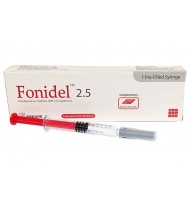Fondaparinux Sodium
Indications
Prophylaxis Of Deep Vein Thrombosis- Fondaparinux is indicated for the prophylaxis of deep vein thrombosis (DVT), which may lead to pulmonary embolism (PE):
Treatment Of Acute Pulmonary Embolism: Fondaparinux is indicated for the treatment of acute pulmonary embolism when administered in conjunction with warfarin sodium when initial therapy is administered in the hospital.
- In patients undergoing hip fracture surgery, including extended prophylaxis;
- In patients undergoing hip replacement surgery;
- In patients undergoing knee replacement surgery;
- In patients undergoing abdominal surgery who are at risk for thromboembolic complications.
Treatment Of Acute Pulmonary Embolism: Fondaparinux is indicated for the treatment of acute pulmonary embolism when administered in conjunction with warfarin sodium when initial therapy is administered in the hospital.
Pharmacology
Fondaparinux, a synthetic pentasaccharide, acts as a selective inhibitor of activated factor X. It works by binding selectively to antithrombin III and potentiates the neutralisation of factor Xa. This will interrupt the blood coagulation cascade and inhibit both thrombin formation and thrombus development.
Dosage & Administration
Superficial vein thrombosis: 2.5 mg once daily for 30-45 days.
Venous thromboembolism:
Venous thromboembolism:
- 50-100 kg: 7.5 mg once daily;
- >100 kg: 10 mg once daily.
- Treatment duration: 5-9 days, or until oral anticoagulation is established.
Interaction
Increased risk of bleeding with (e.g. desirudin, fibrinolytic drugs, glycoprotein IIb/IIIa-receptor antagonists, heparin, heparinoids or LMWH).
Contraindications
Hypersensitivity. Active clinically significant bleeding, acute bacterial endocarditis.
Side Effects
Hip-fracture, hip-replacement, or knee-replacement surgery: Anaemia, fever, nausea, oedema, constipation, rash, vomiting, insomnia, increased wound drainage, hypokalaemia, UTI, dizziness, purpura, hypotension, confusion, bullous eruption, urinary retention, haematoma, major bleeding, diarrhoea, dyspepsia, post-op haemorrhage, and headache. Treatment of venous thromboembolism: Constipation, headache, insomnia, fever, nausea, UTI, and coughing. Abdominal surgery: Post-op wound infection and haemorrhage, fever, surgical site reaction, anaemia, HTN, pneumonia, vomiting.
Pregnancy & Lactation
Pregnancy Category B. Either animal-reproduction studies have not demonstrated a foetal risk but there are no controlled studies in pregnant women or animal-reproduction studies have shown an adverse effect (other than a decrease in fertility) that was not confirmed in controlled studies in women in the 1st trimester (and there is no evidence of a risk in later trimesters).
Lactation: Unknown whether drug is excreted in milk; use with caution
Lactation: Unknown whether drug is excreted in milk; use with caution
Precautions & Warnings
Patient with increased risk of haemorrhage (e.g. congenital or acquired bleeding disorders, history or active Gl ulceration, intracranial haemorrhage, recent brain, spinal or ophth surgery)
Therapeutic Class
Parenteral anti-coagulants
Storage Conditions
Store below 25° C. Do not freeze.
Fonidel Ophthalmic Solution 2.5 mg pre-filled syringe
IndicationsProphylaxis Of Deep Vein Thrombosis- Fondaparinux is indicated for the prophyla..
800.00Tk.
Showing 1 to 1 of 1 (1 Pages)

